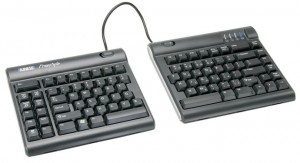The Importance of Ergonomics - Keyboards
Being programmers, we inherently spend a lot of time on our computers. Sitting in a proper position with your your workstation set up correctly is very important to your overall health. One of the most heard of and cataloged injuries from working on a computer is Carpal Tunnel Syndrome. Carpal Tunnel is a compression of the median nerve in your wrist and can cause pain or numbness in your hands and fingers.
One way to help combat carpal tunnel is to use an ergonomic keyboard. Prior to using and ergonomic keyboard I would occasionally get pain in my right wrist. I attributed this partly to mousing, but I knew that my keyboard, which was a standard Dell keyboard, was not set up properly and was the root of the problem. With a normal, straight keyboard such as my old Dell, your arms are bent inward but your wrists are forced to be bent outward in order to line up with the keys on the keyboard. This causes your wrists to be at an awkward angle, which causes pain and discomfort. Ergonomic keyboards, however, angle the keys outward so that although your arms are still slightly bent in, your wrists can remain straight to line up with the keys.
Ergonomic keyboards generally have a split design, and come in 2 variants: fixed and adjustable. Adjustable keyboards work exactly as they sound – you can adjust the angle of the split between the keys:
The keyboard shown above is the Kinesis Freestyle Solo Ergonomic Keyboard. This keyboard allows you to have each keyboard section as much as 8 inches apart from each other as well as adjust the angle that each section is at. If you’re so inclined, you can remove the tether from the keyboard and place the sections as far apart as you want. Although I can’t personally vouch for the quality of this keyboard, I have heard from many people that it is very well made and very comfortable.
The standard split keyboard is similar to the adjustable keyboard but the split is fixed in place:
The keyboard shown above is the Microsoft Natural Ergonomic 4000. This is the keyboard I currently use (I have 1 for work and 1 for home) and I can’t say enough good things about it. The build quality is superb and it is incredibly easy to type on. Also, it actually has the home cluster in the standard positions and has not remapped the function keys (which is essential for a programming keyboard, IMO).
The main reason I love this keyboard is the padded palm rest along with the riser underneath the front of the keyboard. The padded palm rest is a fake-leather-softish material and has enough padding to be comfortable for extended use but not too much that your hands sink in and get stuck. The riser allows your wrists to sit above your desk and be at roughly a 0 degree angle upright (which is very important so you don’t feel like you’ve just Namaste’d all day).
I highly recommend getting an ergonomic keyboard if you spend more than 4 hours a day on a computer. The chances of getting an injury sometime in your computing career is incredibly high and you should do everything you can to minimize the risk. One of the first items to do that should be reviewing your current keyboard situation.

